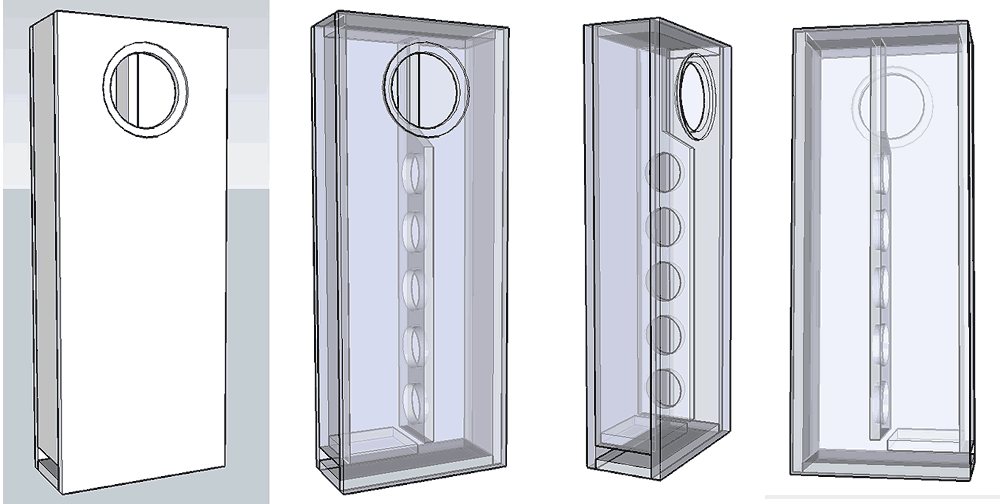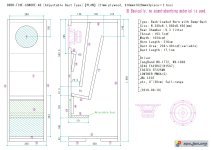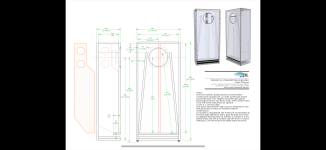Hey everyone. I posted a few days earlier about looking for a fullrange project for my small room. I have since made a lot of progress in my research and my other thread is now deleted.
I have settled for a pair of SB20FRPC30-8s after reading everything I could find about them. Love the look, and they seem like amazing performers for their price.
I'm trying to familiarize myself with enclosure design, but it's going slow since I have zero point of reference, apart from indulging in many of the forum's threads. So I was hoping someone could chime in and push me in the right direction.
Here is a plan of my room with hypothetical speaker placement and listening area.
The (hypothetical) speaker placement is represented by the two, toed in red rectangles. As you can see, they would need to be placed fairly close to a wall, I guess that's something that should influence the design I end up picking.
Here are a few pointers as to what I want:
Any advices welcome, thanks!
I have settled for a pair of SB20FRPC30-8s after reading everything I could find about them. Love the look, and they seem like amazing performers for their price.
I'm trying to familiarize myself with enclosure design, but it's going slow since I have zero point of reference, apart from indulging in many of the forum's threads. So I was hoping someone could chime in and push me in the right direction.
Here is a plan of my room with hypothetical speaker placement and listening area.
The (hypothetical) speaker placement is represented by the two, toed in red rectangles. As you can see, they would need to be placed fairly close to a wall, I guess that's something that should influence the design I end up picking.
Here are a few pointers as to what I want:
- Cabinet size is not an issue, I can go pretty big.
- I would like to milk as much bass capabilities out of these drivers as possible.
- I listen to a lot of electronic music. Deep house, ambient, techno, and some more acoustic genres. So I'm looking for the lowest possible extension. I guess my room will play its part in that search?
- I will almost always listen to them at nearfield levels, sometimes a little more, but I'm not necessarily looking at concert level playback. Just enough to fill my room with sound.
- I intend to buy a UMIK-1 to measure the speakers and correct my room through EQ once they're built
- I like the Betsy-K design a lot aesthetically. I would prefer the speaker to be wide rather than deep, if that's feasable at all.
- I will build stands to prop them up to a good height.
Any advices welcome, thanks!
I can't comment on the room, but some quick modelling I did with the SB20FRPC30-8 suggested you'll need approximately a 60 litre ported cabinet for a reasonable bottom end.
Wide shouldn't be an issue, just try for as large a chamfer, or roundover, on the front baffle as possible.
Wide shouldn't be an issue, just try for as large a chamfer, or roundover, on the front baffle as possible.
There is a nice thread for this driver called full range monster, and inside are designs for pretty much any use case, sealed, vented, MLTL, etc.
You will find what you are looking for in there.
You will find what you are looking for in there.
Thanks for the answers. I read this thread so many times now aha. I looked at all of the designs in there but was wondering whether I could try to do my own thing. I'm a sucker for old Altec designs and wanted to make something that would look similar in terms of aesthetics.

Doesn't have to be massive, but just enough to really get the best of bass extension.
I've been playing around in WinISD, and this what I get with a 150L vented box tuned to 30Hz.

F3 at 26.5Hz which looks great on paper. Then again, I have absolutely zero idea what I'm doing and how this translates to an actual enclosure.
Doesn't have to be massive, but just enough to really get the best of bass extension.
I've been playing around in WinISD, and this what I get with a 150L vented box tuned to 30Hz.
F3 at 26.5Hz which looks great on paper. Then again, I have absolutely zero idea what I'm doing and how this translates to an actual enclosure.
Thanks! As I said, I read this thread and other ones related to the driver several times, but it doesn't answer my questions...
1) Can I build an enclosure that is wider than it is deep? Kind of like the Altec shown above. (I don't like tall and deep towers at all)
2) Does the fact that the speakers will be close to a wall change anything about my design?
Can I do a MLTL in a wide box to maximize bass extension?
This is all new for me. I'm playing around with Hornresp and else but it's very hard to get informations on how to actually do simulation correctly...
Something closer to looking like this:


1) Can I build an enclosure that is wider than it is deep? Kind of like the Altec shown above. (I don't like tall and deep towers at all)
2) Does the fact that the speakers will be close to a wall change anything about my design?
Can I do a MLTL in a wide box to maximize bass extension?
This is all new for me. I'm playing around with Hornresp and else but it's very hard to get informations on how to actually do simulation correctly...
Something closer to looking like this:
Last edited:
Can I do a MLTL in a wide box to maximize bass extension?
Sure

Poplar (in the growing Hardwood Series) is specifically designed for wall placement. Note: some have dimensions suitable for sloped sides to furtehr enhabce integration with the wall.
You do have to pay attention to the alignment. The one you have shown will have WAY too much gain placed against a wall — it likely even has issues just putting it a room. You will need a much “droopier” alignment.
dave
Poplar (in the growing Hardwood Series) is specifically designed for wall placement. Note: some have dimensions suitable for sloped sides to furtehr enhabce integration with the wall.
You do have to pay attention to the alignment. The one you have shown will have WAY too much gain placed against a wall — it likely even has issues just putting it a room. You will need a much “droopier” alignment.
dave
Looks very close to what I would want, thanks Dave!
Two questions:
1) Where can I find this design on your website? I can't seem to find it anywhere...
2) What do you mean by 'alignment' & 'droopier alignment'?
By alignment, he means the shape of the bass response. In a 'droopier 'alignment, the response will 'droop' at the low end, so there will be less low bass.
I think a 150 litre ported box is probably too big, especially with near-wall placement. For ported, you might be better with something more like the 60 litres suggested above.
I think a 150 litre ported box is probably too big, especially with near-wall placement. For ported, you might be better with something more like the 60 litres suggested above.
Last edited:
Here is the whole cover page. Designs done for Pluvia 11, Alpair 10.3 (and a Twin A10.3), P7HD and maybe A7ms in the pipe). A10 version supports angled sides. Email me of Scott about obtaining the paid planset.
http://wodendesign.com/planset/Poplar-A10x-MLTL-teaser.pdf
“Droppier" starts rolling off sooner, and slowly droops down to the lowest frequencies before final rolloff.
Even in the “normal” world F3 is a more or less meaningless number to the human ear/brain (ref Toole), one should be looking at F6 but here it should be F10 or if lots of room gain maybe even less. ie over damped alignment.
dave
http://wodendesign.com/planset/Poplar-A10x-MLTL-teaser.pdf
“Droppier" starts rolling off sooner, and slowly droops down to the lowest frequencies before final rolloff.
Even in the “normal” world F3 is a more or less meaningless number to the human ear/brain (ref Toole), one should be looking at F6 but here it should be F10 or if lots of room gain maybe even less. ie over damped alignment.
dave
Just to make sure....
The Woden design for the Pluvia 11, Alpair 10.3, etc... will NOT be a drop in for the SB20.
As long as CSA is kept the same, and the line length is also the same, it matters less the shape of the enclosure, being wider of narrower. Yes, the width of the baffle will affect the frequency response (baffle step), which may be ok or bad according to the driver's own response, but you say you will have EQ to tame the peaks, so it will be easy.
The lack of depth means the bounce back wave might interfere a bit, so either add some foam like the white magic eraser kitchen sponges or some internal diffuser.
The Woden design for the Pluvia 11, Alpair 10.3, etc... will NOT be a drop in for the SB20.
As long as CSA is kept the same, and the line length is also the same, it matters less the shape of the enclosure, being wider of narrower. Yes, the width of the baffle will affect the frequency response (baffle step), which may be ok or bad according to the driver's own response, but you say you will have EQ to tame the peaks, so it will be easy.
The lack of depth means the bounce back wave might interfere a bit, so either add some foam like the white magic eraser kitchen sponges or some internal diffuser.
for the SB20.
SB20 would require its own design, i posted these for inspiration. The broad strokes can be used, it will need its own height, cross-section, Zd and the details of the mass-loading.
dave
If you have Excel, I'd suggest Bagby's Woofer Box & Circuit Designer (WBCD) to model. (http://audio.claub.net/software/jbabgy/WBCD.html)
Planet10's advice is worth heeding. I think you'd find a 150 L box tuned that low will also severely limit the driver's power handling ability. WBCD will show that.
Planet10's advice is worth heeding. I think you'd find a 150 L box tuned that low will also severely limit the driver's power handling ability. WBCD will show that.
That Altec design is so cool. Those legs gets me 😉
The wide baffle will lower the baffle step an octave compared to modern designs. Perhaps something like Heco Direct Einklang in design would work?
With those room dimentions the lowest room modes are at 42 Hz so tuning way below that is wasteful.
The wide baffle will lower the baffle step an octave compared to modern designs. Perhaps something like Heco Direct Einklang in design would work?
With those room dimentions the lowest room modes are at 42 Hz so tuning way below that is wasteful.
Assuming average box losses and 0,5 Ohm parasitic resistance (cables, connectors, etc) Chebyshev alignment gives 130 Liter box tuned to 32Hz and F3=29Hz. I wouldnt go bigger/lower than this.
Thats cool looking cabinet at post #4, of course you can build it. Shallow and wide box placed against the wall basically gives infinite baffle (half space) radiation. There will be some bass boost by room boundaries and modes but in this case I think its ok taking into account your music taste and SB20FRPC30-8 rising HF response. So my recommendation is against "droopier” alignment.
prairieboy has a point about limited power handling, it wont be able to play very loud at lowest frequencies.
Thats cool looking cabinet at post #4, of course you can build it. Shallow and wide box placed against the wall basically gives infinite baffle (half space) radiation. There will be some bass boost by room boundaries and modes but in this case I think its ok taking into account your music taste and SB20FRPC30-8 rising HF response. So my recommendation is against "droopier” alignment.
prairieboy has a point about limited power handling, it wont be able to play very loud at lowest frequencies.
FYI/FWIW, an Altec/pioneer's 'classic' alignment is Vb = Vas/1.44, Fb = Fs, so a bit under damped with this driver, though the pioneer's solution was to 'critically' dampen the box internally and/or the vent if they felt the need to 'tone down' its midbass response once at the desired in room placement.1) Can I build an enclosure that is wider than it is deep? Kind of like the Altec shown above. (I don't like tall and deep towers at all)
2) Does the fact that the speakers will be close to a wall change anything about my design?
Can I do a MLTL in a wide box to maximize bass extension?
1) Yes and ideally at an acoustic or room ratio, ditto height.
2) Yes, impacts all WLs < ~ it's baffle frequency BW, so typically little/no need for BSC, but likely will need to do the above damping (make its roll off response 'droop') to blend with the room boundaries.
Yes, though until it's at least 36" i.d. it's not a true MLTL, just a tower/column BR IME.
Thank you for all your comments. I've been compulsively reading everything I can find on MLTL design and trying to take it all in. It still feels like I have zero idea what I'm doing.
I tried using a few different softwares. WinISD, Hornsrep, Visaton's BoxSim. But I'm always running into weird issues and I can any proper plot, except in WinISD like I posted above, but it does not help me with designing the actual horn.
What is the go to software you guys would use to help me come up with a design I can put to the test?
Every informations I find seem to be rather dated, or not thorough enough for a complete beginner to make sense of what he should be doing/looking for when designing a cabinet.
For instance, how may I determine how the horn (internal bracings) should look like?
Martin King's MathCAD files seem to be very sturdy in that regard, allowing one to see how damping affects the FR very precisely it seems.
I tried using a few different softwares. WinISD, Hornsrep, Visaton's BoxSim. But I'm always running into weird issues and I can any proper plot, except in WinISD like I posted above, but it does not help me with designing the actual horn.
What is the go to software you guys would use to help me come up with a design I can put to the test?
Every informations I find seem to be rather dated, or not thorough enough for a complete beginner to make sense of what he should be doing/looking for when designing a cabinet.
For instance, how may I determine how the horn (internal bracings) should look like?
Martin King's MathCAD files seem to be very sturdy in that regard, allowing one to see how damping affects the FR very precisely it seems.
MJK's is long since NLA after he found out its most downloads were from a major American/international manufacturer, so mostly we use Hornresp and now with its powerful Wizards, very easy to use for many types of alignments, though some of the latest multiple chamber, pipe combos 'challenge' me.
There was some talk that the Hemp FR8 driver had quite similar specs to the SB20 (Fs, Qts, Qes) while Vas & Qes are quite different - not sure how those apply to a voight design. This is an old design from Planet 10 that fits the Hemp FR8 and has dimensions similar to what you are requesting. Might be worth looking in to.
I don’t think Dave or Scott ever actually commented on whether the plans would be a good fit for the SB20 though. You might need to compare t/s parameters yourself and come to your own conclusion.
On a more anectodal/side note: I’ve noticed that this forum as a whole tends towards encouraging “best practice” rather than “practical practice” which is good and bad. When your speaker positioning and aesthetic requirements require compromise away from “best practice” it often gets downplayed in the advice that follows. Most of the younger generations live in small spaces. Small listening rooms, small distances from walls for placement, small distance from the speakers, etc etc. Wide baffles, close to wall placement and minimal depth of speaker enclosure I think are going to be constantly increasing demands. I know that’s all that fits in my house.
So OP, there is nothing wrong with you sticking to your guns in what you require in your room. Decide if you want to compromise and change your desires or if you’ll just keep chugging on getting what you want/need!
Attachments
Last edited:
- Home
- Loudspeakers
- Full Range
- Help with cabinet design for SB20FRPC30-8

